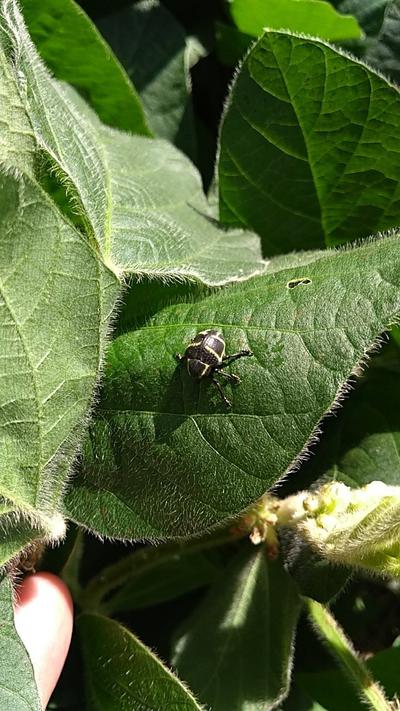Soybean Stalk Weevil
Sternechus subsignatus
Insect
In a Nutshell
- Feeding damage on tender shoots.
- Clipped petioles and girdled stems.
- Development of galls in the girdled part of stems.
- Larva has yellowish-white color with dark brown head.
- Adult weevil black with yellowish lines on their back and head.
Can also be found in
Symptoms
Larvae and adults of Sternechus subsignatus feed on tender stem tissues, mostly during early vegetative stages. Females clip petioles of the leaves and and girdle stems to lay their eggs nearby the damaged tissue, covering them with cut fibres and tissue pieces. Soon after the larvae hatch, they penetrate the stem and feed on the internal tissue, mostly from a stationary position. As they grow and damage the inside of the stem a gall is formed in the girdled part of the stem.
Recommendations

Organic Control
To our knowledge, there is not biological treatment against this diseases. Please contact us if you know of any method that could reduce its incidence and severity.

Chemical Control
Always consider an integrated approach with preventive measures together with biological treatments if available. Chemical control of populations is possible during the periods the larvae spend inside the stalks (about 30 days) and in the soil. Seed and foliar insecticides can also protect the crop, but they only provide short-lived protection, since continuous adult emergence leads to rapid crop reinfestation. Nightly insecticide spraying will show better results, when adults are active and visible on the upper plant parts.
What caused it?
Sternechus subsignatus is active from the early stages of plant development to harvest. The insect spends the latency phase (when soybean plants are not available) in the soil. Before the harvest period, the larvae jump onto the ground and enter hibernation, protected in chambers formed with soil particles. Adults emerge from the soil gradually over a long period of time. Adults hide in the lower third of plants, among the foliage or in the soil and in the plant residues during daytime and become active during the night. Adult females lay eggs on the stem of the plant in a characteristic ring form. Due to the length of the respective life stages, adult, larvae and eggs phases usually overlap on the same plant or field.
Preventive Measures
- Delay your planting date to avoid weevil population peak.
- Surround your soybean plants with non-host crops (maize, millet, sorghum, sunflower) or grasses and plant singular trap plants of soybean in front of your barrier row.
- Remove affected plants.
- Tillage the soil after harvest.
- Practise crop rotation with maize, millet, sorghum or sunflower to decrease insect populations.



